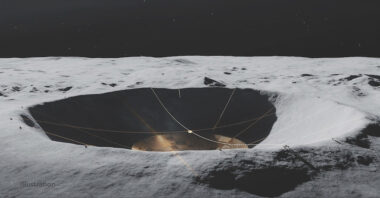18.04.2022

The moon’s far side, ripe for astronomical development? Credit: NASA's Scientific Visualization Studio by Ernie Wright
BOULDER, Colorado — Astronomers have always sought out remote and isolated spots from which their precision observations of the surrounding universe can be made. Now, add one more far-flung location – the moon.
But there is growing concern within the international scientific community regarding the need to keep the far side of the moon free from human-made radio-frequency intrusion.
The lunar far side always faces away from Earth. As a result, it is “radio-quiet,” shielded by the moon itself from radio-frequency interference (RFI) crackling through space, pumped out by powerful Earth-based transmitters.
For years, placing a radio telescope on the moon’s far side has been viewed as the location of choice to carry out matchless studies, such as giving an extraordinary ear to listen for signs of extraterrestrial intelligence.
Shielded zone
A newly established Moon Farside Protection Permanent Committee of the Paris, France-based International Academy of Astronautics (IAA) has started to frame the problem and possible solutions to guard against RFI of the lunar far side, ideal landscape, they say, for a future radio telescope or phased array detector.
Additionally, the International Telecommunication Union, based in Geneva, Switzerland, is engaged in defining and protecting what they label as the Shielded Zone of the moon. However, future moon exploration missions, the ITU warns, could spoil this pristine radio environment through uncontrolled radio emission and even enhance the lunar exosphere, the ultra-wispy layer of gases that acts as an atmosphere.
With the first radio telescope landing on the moon later this year as part of NASA’s Commercial Lunar Payload Services program, radio astronomy from the Moon begins in earnest, said Jack Burns, a space scientist at the University of Colorado, Boulder. That radio astronomy instrument is called ROLSES, he said, a Radio Wave Observations at the Lunar Surface of the photoElectron Sheath. It will fly on the privately-provided Intuitive Machines lander.
“This will be followed by a radio telescope on the lunar far side in 2025 and hopefully arrays of radio dipole antennas later in the decade. So now is the time to begin serious international efforts to protect the lunar far side as a unique radio-quiet preserve for exploration of the early universe,” Burns told SpaceNews.

Unique real estate
Claudio Maccone of the Istituto Nazionale di Astrofisica in Italy is an astronomer, space scientist and mathematician. As chair of the new IAA committee, he is a leading voice to maintain the moon’s far side as unique real estate for scientific activities.
Future space planners, Maccone argues, “need to think ahead and preserve the precious space resources that still remain unpolluted by humankind.” Unfortunately, the undeclared but quite real “current, new race to the moon” complicates matters terribly, he said.
Maccone is pushing to establish a Protected Antipode Circle, or PAC, a large piece of lunar land about 1,130 miles (1,820 kilometers) in diameter that would become the most shielded area of the moon’s moon far side. He said the United Nations should recognize the PAC as an international protected area — a radio-contamination-free zone.
Furthermore, the center of the moon’s far side, specifically Daedalus Crater, is being advanced; its high rim would block Earth-generated “radio smog” from fouling a future radio telescope planted there or other astronomical gear.
Blinder and blinder
Meanwhile, new ideas about taking advantage of the lunar far side’s special qualities have come to the forefront. For example, the NASA Innovative Advanced Concepts (NIAC) program has awarded study money for a Lunar Crater Radio Telescope. This proposal centers on using crater wall-climbing robots to deploy wire mesh to form a large parabolic reflector.
Another moon-situated NIAC-supported proposal is FarView – a radio observatory fabricated on the moon. This concept would utilize roughly 100,000 networked dipole antennas spread across hundreds of miles of lunar terrain. FarView science would support a detailed investigation of the unexplored “Cosmic Dark Ages,” the conditions and processes under which the first stars, galaxies, and accreting black holes formed.
“The far side of the moon is a unique place for us in the whole universe,” said Maccone. “It is close to the Earth, but protected from the radio emissions that we ourselves are creating in an ever-increasing amount, and that is making our radio telescopes blinder and blinder.”
Quelle: SN
